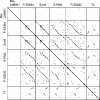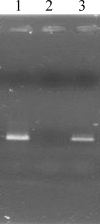Ma-LMM01 infecting toxic Microcystis aeruginosa illuminates diverse cyanophage genome strategies
- PMID: 18065537
- PMCID: PMC2258655
- DOI: 10.1128/JB.01534-07
Ma-LMM01 infecting toxic Microcystis aeruginosa illuminates diverse cyanophage genome strategies
Abstract
Cyanobacteria and their phages are significant microbial components of the freshwater and marine environments. We identified a lytic phage, Ma-LMM01, infecting Microcystis aeruginosa, a cyanobacterium that forms toxic blooms on the surfaces of freshwater lakes. Here, we describe the first sequenced freshwater cyanomyovirus genome of Ma-LMM01. The linear, circularly permuted, and terminally redundant genome has 162,109 bp and contains 184 predicted protein-coding genes and two tRNA genes. The genome exhibits no colinearity with previously sequenced genomes of cyanomyoviruses or other Myoviridae. The majority of the predicted genes have no detectable homologues in the databases. These findings indicate that Ma-LMM01 is a member of a new lineage of the Myoviridae family. The genome lacks homologues for the photosynthetic genes that are prevalent in marine cyanophages. However, it has a homologue of nblA, which is essential for the degradation of the major cyanobacteria light-harvesting complex, the phycobilisomes. The genome codes for a site-specific recombinase and two prophage antirepressors, suggesting that it has the capacity to integrate into the host genome. Ma-LMM01 possesses six genes, including three coding for transposases, that are highly similar to homologues found in cyanobacteria, suggesting that recent gene transfers have occurred between Ma-LMM01 and its host. We propose that the Ma-LMM01 NblA homologue possibly reduces the absorption of excess light energy and confers benefits to the phage living in surface waters. This phage genome study suggests that light is central in the phage-cyanobacterium relationships where the viruses use diverse genetic strategies to control their host's photosynthesis.
Figures





Similar articles
-
Cyanophage infection in the bloom-forming cyanobacteria Microcystis aeruginosa in surface freshwater.Microbes Environ. 2012;27(4):350-5. doi: 10.1264/jsme2.me12037. Epub 2012 Oct 5. Microbes Environ. 2012. PMID: 23047146 Free PMC article. Review.
-
Isolation and characterization of a cyanophage infecting the toxic cyanobacterium Microcystis aeruginosa.Appl Environ Microbiol. 2006 Feb;72(2):1239-47. doi: 10.1128/AEM.72.2.1239-1247.2006. Appl Environ Microbiol. 2006. PMID: 16461672 Free PMC article.
-
Transcriptome Analysis of a Bloom-Forming Cyanobacterium Microcystis aeruginosa during Ma-LMM01 Phage Infection.Front Microbiol. 2018 Jan 19;9:2. doi: 10.3389/fmicb.2018.00002. eCollection 2018. Front Microbiol. 2018. PMID: 29403457 Free PMC article.
-
Development of a real-time PCR assay for the quantification of Ma-LMM01-type Microcystis cyanophages in a natural pond.Lett Appl Microbiol. 2015 Apr;60(4):400-8. doi: 10.1111/lam.12387. Epub 2015 Feb 18. Lett Appl Microbiol. 2015. PMID: 25580646
-
Cyanophage Engineering for Algal Blooms Control.Viruses. 2024 Nov 6;16(11):1745. doi: 10.3390/v16111745. Viruses. 2024. PMID: 39599859 Free PMC article. Review.
Cited by
-
A Novel Jumbo Phage PhiMa05 Inhibits Harmful Microcystis sp.Front Microbiol. 2021 Apr 20;12:660351. doi: 10.3389/fmicb.2021.660351. eCollection 2021. Front Microbiol. 2021. PMID: 33959116 Free PMC article.
-
Cyanophage infection in the bloom-forming cyanobacteria Microcystis aeruginosa in surface freshwater.Microbes Environ. 2012;27(4):350-5. doi: 10.1264/jsme2.me12037. Epub 2012 Oct 5. Microbes Environ. 2012. PMID: 23047146 Free PMC article. Review.
-
Horizontal gene transfers with or without cell fusions in all categories of the living matter.Adv Exp Med Biol. 2011;714:5-89. doi: 10.1007/978-94-007-0782-5_2. Adv Exp Med Biol. 2011. PMID: 21506007 Free PMC article. Review.
-
Development of phoH as a novel signature gene for assessing marine phage diversity.Appl Environ Microbiol. 2011 Nov;77(21):7730-9. doi: 10.1128/AEM.05531-11. Epub 2011 Sep 16. Appl Environ Microbiol. 2011. PMID: 21926220 Free PMC article.
-
Novel Freshwater Cyanophages Provide New Insights into Evolutionary Relationships between Freshwater and Marine Cyanophages.Microbiol Spectr. 2021 Oct 31;9(2):e0059321. doi: 10.1128/Spectrum.00593-21. Epub 2021 Sep 29. Microbiol Spectr. 2021. PMID: 34585945 Free PMC article.
References
-
- Altschul, S. F., W. Gish, W. Miller, E. W. Myers, and D. J. Lipman. 1990. Basic local alignment search tool. J. Mol. Biol. 215403-410. - PubMed
-
- Angly, F. E., B. Felts, M. Breitbart, P. Salamon, R. A. Edwards, C. Carlson, A. M. Chan, M. Haynes, S. Kelley, H. Liu, J. M. Mahaffy, J. E. Mueller, J. Nulton, R. Olson, R. Parsons, S. Rayhawk, C. A. Suttle, and F. Rohwer. 2006. The marine viromes of four oceanic regions. PLoS Biol. 4e368. - PMC - PubMed
-
- Baier, K., H. Lehmann, D. P. Stephan, and W. Lockau. 2004. NblA is essential for phycobilisome degradation in Anabaena sp. strain PCC 7120 but not for development of functional heterocysts. Microbiology 1502739-2749. - PubMed
-
- Bergh, O., K. Y. Borsheim, G. Bratbak, and M. Heldal. 1989. High abundance of viruses found in aquatic environments. Nature 340467-468. - PubMed
Publication types
MeSH terms
Associated data
- Actions
LinkOut - more resources
Full Text Sources
Molecular Biology Databases
Research Materials

